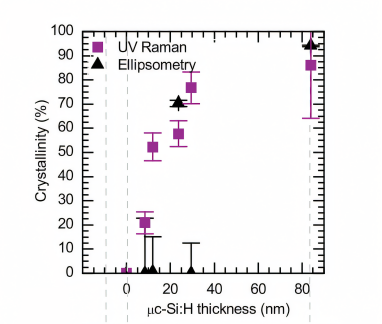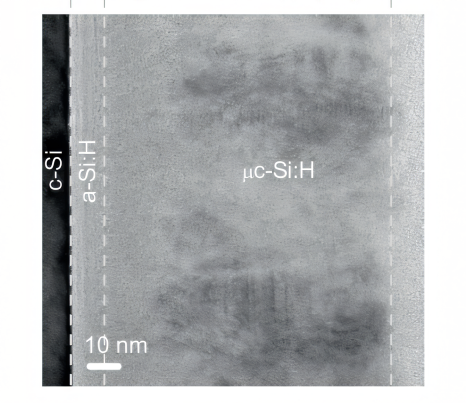
量子效率测试仪
PL/EL一体机
Sinton硅片少子寿命测试仪
Sinton硅块少子寿命测试仪
绒面反射率测试仪
3D共聚焦显微镜
清洗制绒工作站
在线四探针方阻测试仪
全自动扫描四探针方阻测试仪
在线薄膜厚度测试仪
晶化率测试仪
Horiba显微共焦拉曼光谱仪
傅里叶红外光谱仪
霍尔效应测试仪
分光光度计
全光谱椭偏仪
Horiba椭圆偏振光谱仪
TLM接触电阻率测试仪
超景深显微镜
网版智能影像测量仪
全自动影像测量仪
卧式拉力机
电池片稳态光衰老化试验箱
电池片紫外老化试验箱
电池片拉脱力综合测试仪
外观检验台
湿漏电测试系统
组件实验室EL测试仪
紫外老化试验箱
稳态光衰老化试验箱
电流连续性监测系统
PID测试系统
旁路二极管测试系统
LeTID测试系统
反向电流过载系统
脉冲电压测试系统
绝缘耐压测试仪
接地连续性测试仪
绝缘耐压接地测试仪
湿热环境试验箱
湿冻环境试验箱
热循环试验箱
动态机械载荷测试机
静态机械载荷测试机
冰雹冲击试验机
引出端强度试验机
霰弹冲击试验机
抗划伤(切割)测试机
剥离试验机
万能材料试验机(单臂)
万能材料试验机(双臂)
光伏玻璃透过率测试仪
醋酸测试试验箱
交联度测试系统
二极管接线盒综合测试仪
落球冲击试验机
半自动四探针
全自动探针式台阶仪
多通道太阳能MPPT系统
Horiba稳瞬态荧光光谱仪
钙钛矿P1激光划线测试仪
钙钛矿在线膜厚测试仪
钙钛矿工艺检测工作站
手持式IV测试仪
便携式EL测试仪
手持热成像测试仪
户外组件IV测试仪
户外组件多通道测试系统
光伏逆变器电能质量测试仪
无人机EL检测仪
紫外拉曼光谱在微晶硅薄膜结晶度分析中的优势
日期:2024-09-09浏览量:20
硅薄膜的结晶度(晶体结构所占的比例)对光伏电池性能至关重要。由于大多数硅薄膜表征信号会被衬底信号掩盖,因此难以确定其结晶度。拉曼光谱、椭偏光谱、透射电子显微镜(TEM)等技术都常被用于测量硅薄膜的结晶度,其中拉曼光谱最快捷,在短短几秒钟内,波长或偏振的变化就能够揭示出样品的相关信息。美能晶化率测试仪采用325激光器,优化紫外光路设计,提高光谱稳定性,高效率利用325激光与样品拉曼信号,实现了5nm以上非晶/微晶材料的原位测试。
晶体、多晶、微晶硅和非晶硅中光的穿透深度

光在晶体、多晶、微晶和非晶硅中的穿透深度
我们使用325 nm紫外拉曼激发来分析不同晶体结构硅材料的结晶度。如图所示,325nm光在非晶硅薄膜中的穿透深度仅为8nm,在微晶硅薄膜中的穿透深度为8.5nm,⼏乎具有相同的穿透深度。常用的拉曼光谱波长还有514和532nm,对晶体硅和非晶硅的穿透深度相差10倍,这表明不同波长光在硅材料中穿透深度的差异性。
遮蔽底层硅片信号的非晶硅薄膜厚度范围

在325 nm激发下,不同厚度的非晶硅薄膜的拉曼光谱
图中可以看到,对于0.3nm至12.6nm之间的非晶硅薄膜,能看到来自底层硅片的晶体硅峰,但对于14.9nm(或更厚)的薄膜,则不可见。非晶硅薄膜的厚度对底层硅片信号在拉曼光谱中显现的影响,大致确定了能够完全遮蔽底层硅片信号的薄膜厚度范围。

不同厚度的非晶硅薄膜对拉曼信号的影响
如图所示,对于 325nm 激发和非晶硅或微晶硅薄膜,拉曼检测厚度(RDT)为 13nm,这意味着 13nm 或更厚的薄膜可以用紫外拉曼分析,并且13nm厚的薄膜对于拉曼分析更具代表性。
不同衬底上微晶硅薄膜的拉曼光谱对比
氢化微晶硅薄膜:分别在c-Si和Al2O3衬底上制备了16.6 nm的氢化微晶硅薄膜。
基底处理:均涂有PECVD沉积的10 nm的SiO2(拉曼透明),以确保后续氢化微晶硅层的相同生长。

16.6nm 厚的微晶硅薄膜在不同衬底上的拉曼光谱
SiO2/Al2O3衬底上的氢化微晶硅薄膜:325nm 激发下测量的结晶度(68%)略高于 532nm 激发下的结晶度(55%),这是因为薄膜的顶部比底部更容易结晶,而较短的波长(325nm)对薄膜表面更敏感。
SiO2/c-Si 衬底上的氢化微晶硅薄膜:532nm 拉曼光谱受到硅衬底信号的强烈干扰,而325nm 拉曼光谱测得的结晶度与在 SiO2/Al2O3上测量的结果几乎相同(66%)。
由此表明,325nm 拉曼光谱对硅衬底不敏感,更适用于分析微晶硅薄膜的结晶度,而 532nm 拉曼光谱会受到硅衬底信号的干扰。
微晶硅薄膜结晶度与厚度的关系

![]()
微晶硅薄膜结晶度-随薄膜厚度变化情况
上图表明,紫外拉曼结晶度随着微晶硅薄膜厚度的增加而稳步增加,在84nm后达到约90%的饱和,这反映了薄膜的结晶度与厚度存在依赖关系。
椭偏仪确定的结晶度对于大多数薄膜,结晶度接近零,而对于 24 和 84nm 厚的薄膜,结晶度则跃升至 60% 以上。这表明椭偏仪在测量结晶度时存在一定的困难,难以准确反映薄膜的结晶度变化。

最厚(84nm)微晶硅薄膜的TEM图像
TEM图像对于具有锥形晶体的较厚薄膜更容易转换成黑白对比图像。紫外拉曼可以用来监测微晶硅薄膜的结晶度,数据与TEM图像中明显的晶体区域在定性上是一致的。
综上所述,紫外拉曼在测量微晶硅薄膜结晶度方面具有优势,能够更准确地反映薄膜的结晶度与厚度的关系。
美能晶化率测试仪

联系电话:400 008 6690
美能晶化率测试仪拥有极佳的紫外灵敏度和优异的光谱重复性。采用325激光器,同时优化紫外光路设计,提高光谱稳定性,高效率利用325激光与样品拉曼信号,实现了5nm以上非晶/微晶材料的原位测试,是表征"微晶一异质结"电池的最优选择。
n 行业最佳,紫外灵敏度硅一阶峰的信号计数优于1000(1秒积分时间)
n 光谱重复性:单晶硅校准后,≤520±0.02cm-1
n 光栅刻线数:≤2400 gr/mm;≤1800 gr/mm
常见的拉曼光谱波长在分析硅薄膜时存在问题,而 325nm激光在分析薄的硅薄膜结晶度时具有优势,其在硅材料中的穿透深度合适,且对衬底信号不敏感。美能晶化率测试仪采用穿透深度较浅325nm激光器,能够实现晶化率的原位测试高效精确的一键输出晶化率数值。




































































